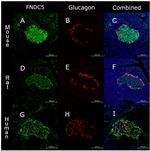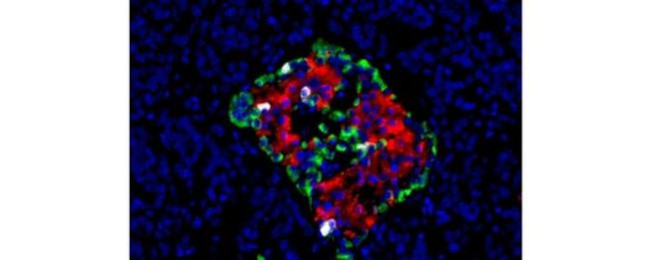Search Thermo Fisher Scientific
Invitrogen
Glucagon Monoclonal Antibody (ICACLS), Alexa Fluor™ 488, eBioscience™
FIGURE: 1 / 2
Glucagon Antibody (53-9743-82) in IHC (P)


Product Details
53-9743-82
Species Reactivity
Published species
Host/Isotype
Recommended Isotype Control
Class
Type
Clone
Conjugate
Excitation/Emission Max
Form
Concentration
Purification
Storage buffer
Contains
Storage conditions
Shipping conditions
RRID
Product Specific Information
Description: This ICACLS monoclonal antibody reacts with human, mouse, and rat glucagon. Glucagon is a peptide hormone secreted by the pancreatic alpha cells found within the islets of Langerhans. Glucagon functions as an antagonist to insulin and homeostatic regulation of blood glucose levels are maintained by the critical balance between these two hormones. Glucagon acts in the liver to convert glycogen to glucose by promoting gluconeogenesis and glycogenolysis. Secretion of glucagon is stimulated by hypoglycemia, epinephrine, acetylcholine, and cholecystokinin, while secretion is inhibited by insulin and somatostatin. Abnormally high levels of glucagon are found in pancreatic tumors.
Applications Reported: This ICACLS antibody has been reported for use in immunohistochemical staining, and immunohistochemical staining of formalin-fixed paraffin embedded tissue sections.
Applications Tested: This ICACLS antibody has been tested by immunohistochemistry of formalin-fixed paraffin embedded human tissue using low pH antigen retrieval and can be used at less than or equal to 10 µg/mL. It is recommended that the antibody be carefully titrated for optimal performance in the assay of interest.
Excitation: 488 nm; Emission: 519 nm; Laser: Blue Laser.
Filtration: 0.2 µm post-manufacturing filtered.
Target Information
Glucagon is a 29-residue polypeptide hormone (MW 3482), produced in the pancreas. A related hormone, enteroglucagon (or oxyntomodulin), which is produced in the mucosa of the small and large intestine, consists of the 29 amino acid sequence of pancreatic glucagon extended by 8 additional residues at the C-terminus. The biological activities of pancreatic glucagon include glycogenolysis, lipolysis, gluconeogenesis, and ketogensis, which are antagonistic effects to those of insulin action, thus leading to increased blood glucose levels. Immunocytochemical studies have revealed the presence of pancreatic glucagon inside the A or alpha cells, which constitute 15-20% of the islet cell population. These cells are located preferentially at the periphery of the human pancreatic islets. Pathological manifestations of the glucagon-type peptide residue almost exclusively with the exsistence of tumors or glucagonomas, as no states of glucagon-cell deficiency or hyperplasia have been identified. Glucagon-specific antibodies would prove useful as a cell and tumor markers applying immunohistochemical techniques, and as an analytical tool in qualification of the hormone.
For Research Use Only. Not for use in diagnostic procedures. Not for resale without express authorization.
Bioinformatics
Protein Aliases: glicentin-related polypeptide; GLP1/2; glucagon; glucagon-like peptide 1; glucagon-like peptide 2; glucagon-like peptide-1; IL12p35; IL12P40; OXY; preproglucagon; Pro-glucagon
Gene Aliases: GCG; GLP-1; GLP1; GLP2; Glu; GRPP; PPG
UniProt ID: (Human) P01275, (Mouse) P55095
Entrez Gene ID: (Human) 2641, (Mouse) 14526, (Rat) 24952

Performance Guarantee
If an Invitrogen™ antibody doesn't perform as described on our website or datasheet,we'll replace the product at no cost to you, or provide you with a credit for a future purchase.*
Learn more
We're here to help
Get expert recommendations for common problems or connect directly with an on staff expert for technical assistance related to applications, equipment and general product use.
Contact tech support

